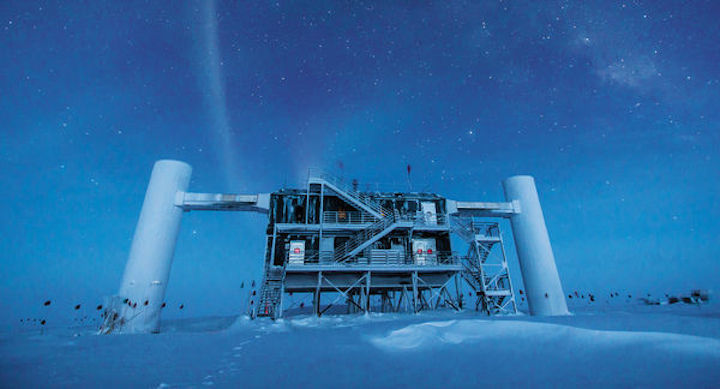2.11.2017

The IceCube Laboratory at the Amundsen–Scott South Pole Station.
Mark Bowen, a physicist-turned-writer, sets his sights high in The Telescope in the Ice, the history of a detector buried in Antarctic ice since the 1990s. The IceCube observatory is designed to do the near-impossible: track neutrinos. These tiny particles whiz through the Universe in staggeringly huge numbers while hardly ever interacting with matter; billions upon billions are passing through your body right now.
IceCube and its predecessor, the Antarctic Muon and Neutrino Detector Array (AMANDA), are international collaborations led by the University of Wisconsin–Madison (UW–Madison) and located at the Amundsen–Scott South Pole Station. Their detectors, arrays of optical modules on strings, are sunk into the ice sheet. The AMANDA group coalesced at a cosmic-ray meeting in 1990. By 1994, it had installed 4 strings; by 2000, that had grown to 19. IceCube, established in 2005, began adding more. By the time it had finished construction 6 years later, pushed through by supporters including principal investigator Francis Halzen, it had 86 strings studded throughout a cubic kilometre of ice.
Bowen has been embedded in this project since 1998. During those decades, he has had access to team meetings and other insider information, much as sociologist Harry Collins has with researchers hunting gravitational waves at the Laser Interferometer Gravitational-Wave Observatory (LIGO; see Nature 542, 28–29; 2017). Both observatories use expensive, technologically challenging machines to answer profound physics questions. Whereas Collins spun erudite, sociologically distanced tales, Bowen comes off as more of a booster.
The Telescope in the Ice begins with a brisk history of neutrinos. In 1930, the theoretical physicist Wolfgang Pauli put forward the idea of an electrically neutral, nearly massless particle emitted during β radioactive decay. In 1956, physicists Clyde Cowan and Frederick Reines reported measuring about three neutrinos per hour coming from a nuclear reactor in South Carolina. Bowen sketches these and other discoveries while noting some of the scientists' personal quirks, such as Pauli's tendency to party and Reines's aggressiveness in staking claims.
By 1960, physicists including Moisei Markov and Kenneth Greisen were beginning to dream up ways to capture the fleeting particles. Markov's contribution was the plum-pudding model, in which detectors are embedded in a 3D grid. When a neutrino interacts with the surrounding material, it generates another particle, a muon. The muon rushes on in the general direction in which the neutrino had been going, creating pale-blue radiation. By capturing and analysing the tracks of blue light, physicists hope to recreate the path and energy of the neutrino. The detector, however, must have immense amounts of shielding to screen out the confounding effects of cosmic rays. Some observatories are buried deep in rock; for the team that would create AMANDA and IceCube, that screening meant Antarctic ice.
Bowen's involvement began in 1997, when he encountered ice driller Bruce Koci while reporting on efforts to acquire ice cores from mountain glaciers. In the off season, Koci worked for AMANDA, decamping to the South Pole to drill and melt the long boreholes needed to take the detector-laden strings — the plums in the pudding. Koci had to invent new methods for solving issues such as how to keep the huge tanks of water hot, and maintain the flow. In the first season, 1991–92, the team lost the drill. It also became apparent that there were more bubbles in the ice than expected, which interfered with the detectors' ability to capture the faint glow from travelling muons. That meant going even deeper into the ice — and the birth of IceCube. Its detectors start about 1.5 kilometres below the surface.
The Telescope in the Ice acknowledges the many external factors that can help a large scientific project to completion. The fortunes of IceCube (which cost a cool US$279 million to build) were bolstered, for instance, by an influential 1997 report chaired by aerospace executive Norman Augustine; this stressed the importance of international cooperation at the pole, with a subtext of maintaining US dominance in Antarctic research. In 2000, when the Lawrence Berkeley Laboratory in California proposed itself as lead institution for IceCube, the Wisconsin contingent tussled with George Smoot, a future Nobel laureate who wanted to take over as principal investigator. (He failed.) And a well-timed 2002 visit to a White House office by the UW–Madison group, including Halzen, helped to override the reluctance of National Science Foundation (NSF) director Rita Colwell. Bowen covers every twist and turn of the budgetary debates, technological challenges and scientific scepticism, including the occasional much-needed loan from UW–Madison when the NSF could not cough up enough funding.
From AMANDA — a telescope no one was sure would work — to IceCube, the 'Fellowship of the Cube' managed to realize its dream of detecting neutrinos in 2011. Today, IceCube spots about 100,000 atmospheric neutrinos a year. In 2013, it reported the first very-high-energy neutrinos coming from outside the Solar System, and each day it sweeps up more and more data, fulfilling Halzen's vision. From his spot within the fellowship, Bowen does justice to its story.
Quelle: nature
